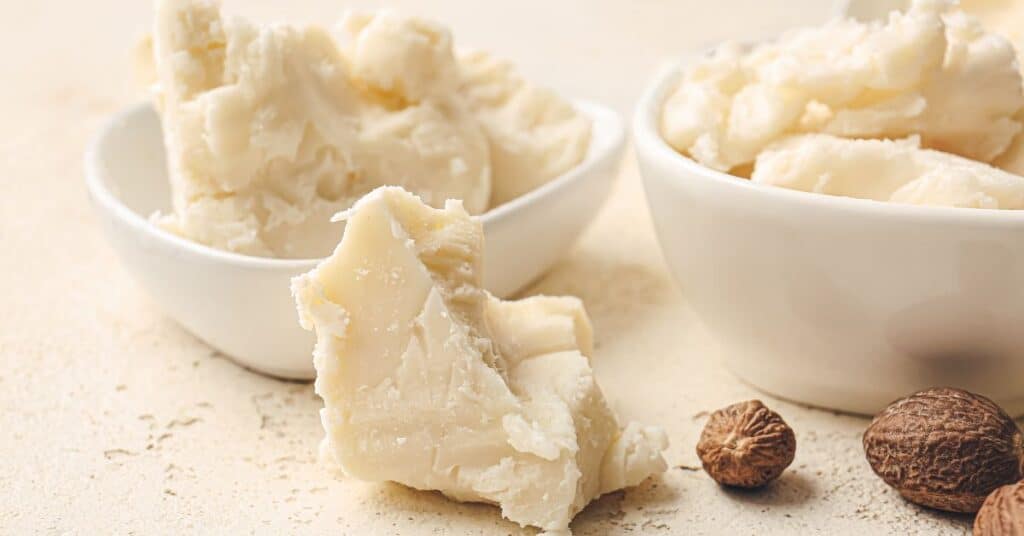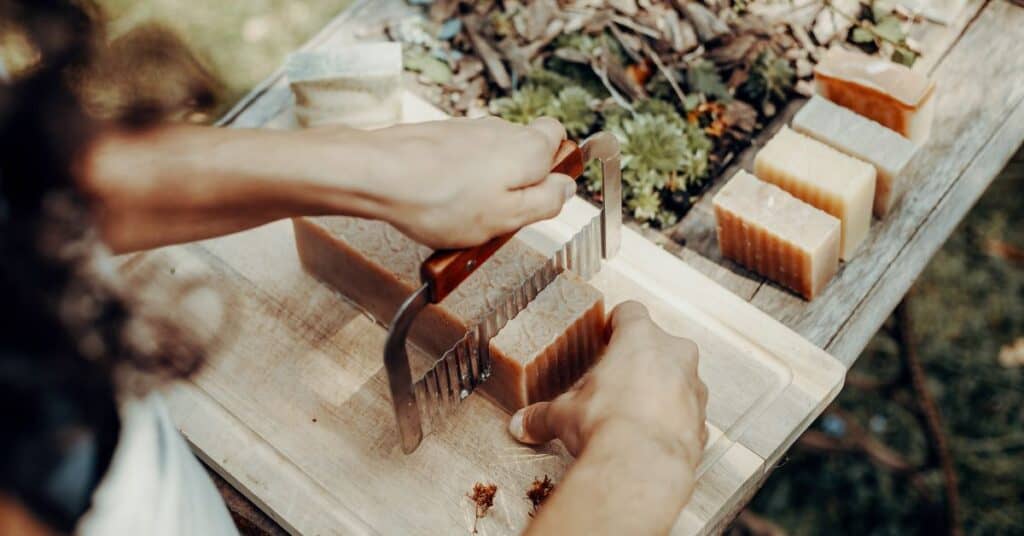Table of Contents
- How Do You Render Fat To Make Soap?
- Why Does Soap React With Fat?
- What is the fat used in soap?
- Why is soap fat soluble?
- Final Thought
How Soap Is Made From Fat? Soap results from the reaction between a fatty substance and another alkaline substance (sodium hydroxide or caustic soda: NaOH). This reaction is called saponification.
This process involves converting oils or fats into soap and glycerin with the help of an alkali solution, such as sodium hydroxide (for solid soap) or potassium hydroxide (for liquid soap).
When I started as a soap maker, I was curious about the chemical reaction process of soap making, and trust me, I went on that journey of research, and I will share my findings with you.
The process of soap-making from fat is an age-old technique refined over centuries.
Let’s explore how fat transforms into the cleansing agents we use daily.
How Do You Render Fat To Make Soap?
Rendering fat to make soap is a process that involves melting down animal fats or vegetable oils to extract the usable components for soap-making. Here are the general steps to render fat for soap-making:
1. Choose High-Quality Fat: Use pure oils free from additives.
For animal fats, choose high-quality fats like beef tallow (from beef), lard (from pork), or poultry fats (from chicken or duck). Ensure the fat is fresh and free from contaminants.
2. Trim away any excess meat or connective tissue from the fat.
3. Melting the Fat: when I’m using beef fat (also known as tallow oil), before melting the fat, I wash it, put it in a pot, and add 1 glass of water; depending on the quantity, I let it steam for 10-15 minutes.
The purpose of steaming the fat is to soften it so it is easy to grind or mash and extract enough oil from the fat.
After mashing or grinding it, of course, there will be some water left from the first steaming. Put the mashed fat back into the pot and mix with a spoon; at this point, you want to ensure all the water evaporates and all you are left with is the fat.
Put your cooker on low heat so you don’t get scorched or burnt oil due to high heat, and let it steam for at least 25-30 minutes until all that’s left in the pot is oil and some meat bits.
Also, stir the fat occasionally to ensure even melting. Rendering fat is similar to infusing oil with herbs using the hot infusion method.
4. Straining the Rendered Fat: Straining helps produce a cleaner and purer fat for soap-making.
As the fat melts, impurities like meat bits, skin, or debris will separate from the fat.
Use a fine mesh strainer, cheesecloth, or a clean muslin cloth to strain the melted fat and remove these impurities.
Why Does Soap React With Fat?
Soap reacts with fat due to a chemical process called saponification.
Saponification is the reaction between fats (or oils) and an alkali, such as sodium hydroxide (NaOH) or potassium hydroxide (KOH), to produce soap molecules and glycerin.
This reaction occurs due to the unique properties of both fats and alkalis. The basic formula for soap-making can be expressed as follows:
For Solid Soap (Bar Soap):
Oils/Fats (Triglycerides) + Sodium Hydroxide (NaOH) = Soap + Glycerin
For Liquid Soap:
Oils/Fats (Triglycerides) + Potassium Hydroxide (KOH) = Soap + Glycerin
The chemical equation representing the saponification process is more detailed and includes the specific molecules involved:
For Solid Soap (Bar Soap):
Triglyceride (3 Fatty Acids bonded to Glycerol) + 3 NaOH = 3 Soap Molecules + Glycerin
For Liquid Soap:
Triglyceride (3 Fatty Acids bonded to Glycerol) + 3 KOH = 3 Soap Molecules + Glycerin
In these equations:
Triglycerides are derived from oils or fats and consist of three fatty acid chains bonded to a glycerol (glycerin) molecule.
The fatty acids released from the triglycerides react with the alkali ions (sodium or potassium ions) from the alkali solution.
This reaction is called neutralization, where the carboxylic acid group (-COOH) in fatty acids reacts with the alkali to form carboxylate ions (-COO-).
These carboxylate ions combine with sodium ions (Na+) from NaOH or potassium ions (K+) from KOH to form soap molecules.
It’s important to note that the specific amounts of oils/fats and alkali (NaOH or KOH) used in soap-making are determined by a soap calculator or formula based on the desired properties of the soap, such as hardness, lather, cleansing ability, and conditioning properties.
Additionally, other factors such as water content, temperature, and additives (like fragrances, colorants, and herbs) influence the soap-making process and final product characteristics.
What is the fat used in soap?
There are many fats/oils available for soap making, like tallow (fat from beef), lard (fat from pig), coconut oil, olive oil, cocoa butter, shea butter, palm kernel oil, etc.
Your choice of soap determines the kind of oil/fat that will be used. More on the properties of oil for soap making.
Why is soap fat soluble?
Soap’s fat solubility results from its amphiphilic nature, micelle formation, and ability to surround and disperse oil and grease particles in water, making it an effective cleaner for a wide range of surfaces contaminated with oils and fats.
By amphiphilic nature, I mean Soap molecules are amphiphilic, meaning they have both hydrophilic (water-attracting) and hydrophobic (water-repelling) parts in their structure.
The hydrophilic part is typically the ionic head of the soap molecule, which is attracted to water molecules (polar molecules).
The hydrophobic part is the long hydrocarbon chain, usually derived from fatty acids, which repels water but is attracted to oils, fats, and grease (nonpolar molecules).
The micelle formation results from combining hydrophilic and hydrophobic parts in soap’s structure that surround and encapsulate oil and grease particles.
They effectively lift dirt off surfaces and keep them suspended in water, preventing re-deposition onto the cleaned surface.
Final Thought
Understanding the journey from fat to soap through saponification sheds light on the craftsmanship of producing quality soaps.
Making soap from animal fat is a rewarding process. It’s beneficial to your skin and produces a rich lather.
Whichever soap-making method you choose, Selecting the right fat and recipe is essential to the soap’s result.



